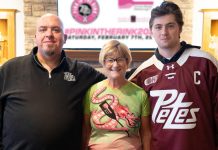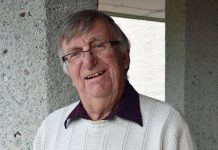
Peterborough Pride, the annual celebration welcoming all people regardless of their sexuality or gender identity, returns for its 21st year in Peterborough-Nogojiwanong from Friday, September 15th until Sunday, September 24th.
The origins of the Peterborough celebration go back to 2003, when Peterborough’s then-mayor Sylvia Sutherland proclaimed September 13th as “Gay Pride Day”. On that day, 300 people gathered in front of City Hall to participate in the very first Pride parade in Peterborough.
Since then, Peterborough Pride has grown into a full week of fun and informative events in mid-September to celebrate diversity and to support the 2SLGBTQIA+ community, culminating in the Pride parade at the end of the week.
“2SLGBTQIA+” stands for “Two Spirit, Lesbian, Gay, Bisexual, Transgender, Queer, Intersex, Androgynous and Asexual”, with the “+” suffix meant to accommodate additional sexual and gender identities that may arise. (For those interested in understanding what these terms mean, the Peterborough Pride organization has provided a glossary we’ve included at the end of this story.)
The theme of this year’s Peterborough Pride Week, which features more than 30 community-run virtual and in-person events, is “LOVE. OUT. LOUD.”
“It’s a set of values or conditions that tell the world that ‘we’re here, we’re queer, get used to it!’,” reads a media release from Peterborough Pride. “‘Love out loud’ describes how queer folks aspire to exist in communities worldwide. It’s a rallying cry for visibility and safety as the 2SLGBTQIA+ community faces threats from those who wish to silence us. To love who we want, openly and visibly and have our voices heard. Our community calls for compassionate love, bodily autonomy, and celebration. We invite everyone to embrace the theme of Pride Week, take action and make it your own.”
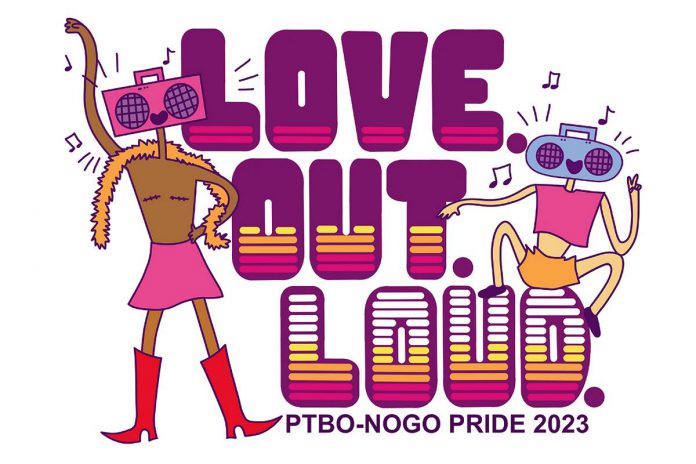
The week begins with a flag-raising ceremony at noon on Friday, September 15th at Peterborough City Hall, where Mayor Jeff Leal will read the city’s proclamation of Pride Week and the Progressive Pride Flag will be raised on the south lawn of City Hall.
The week ends with the Pride Parade in downtown Peterborough on Saturday, September 23rd starting at 2 p.m. at City Hall. After the parade, the “Pride in the Park” event takes place at Millennium Park from around 2:30 to 6 p.m. The family-friendly event will include live music, information booths from groups and agencies that support the LGBTQ+ community, vendors, a beer and beverage tent, a Peterborough Lions Club food booth serving burgers, hot dogs, and sausages, and a family and children’s area with activities for the entire family.
“We invite everyone to show their Pride and express their feelings by decorating their homes and businesses to signal that they are part of a welcoming community where nobody needs to feel alone or unsafe,” reads a media release from Peterborough Pride. “Everyone should be able to live and love as they wish with dignity and without fear. Freedom from oppression and discrimination of any sort should be a basic human right that all humans can enjoy.”
The Peterborough Pride organization is made up entirely of volunteers and is supported by the City of Peterborough, community organizations, local businesses, and the broader community. For more about Peterborough Pride and a detailed listing of events during Peterborough-Nogojiwanong Pride Week, visit www.peterboroughpride.ca.
The following background material has been supplied by the Peterborough Pride organization:
History of Pride Celebrations
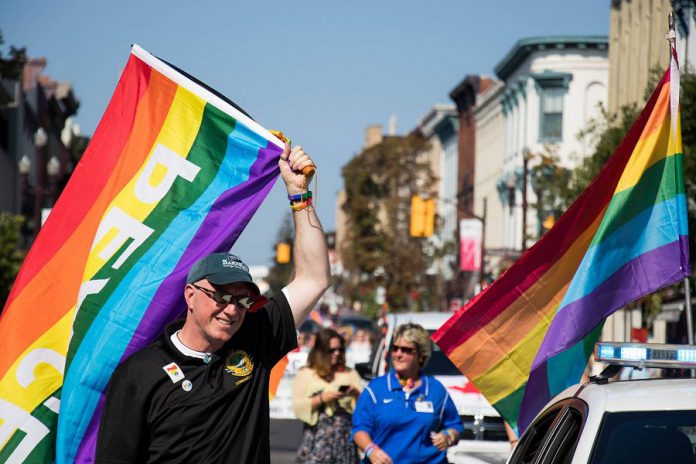
Formal Pride parades and related events have taken place around the globe for close to 50 years, beginning with New York’s first Pride march in 1969.
This event was held to commemorate the Stonewall Riots, which resulted when the LGBTQ+ community took a stand against police harassment and brutality, fighting back as policemen attempted to force them out of the Stonewall Inn.
Since then, Pride events have been a way of rallying for equal rights in regards to sexual orientation and gender identity. The response to these celebrations varies depending on the hosting countries, cities and current circumstances. In some places, Pride events are met with brutal physical violence from the state, police, and groups who oppose LGBTQ+ rights.
With Pride we acknowledge the history and ongoing fight for equality and human rights, celebrate the diversity within the LGBTQ+ community, work to improve the quality of life for LGBTQ+ community members, and send a message to the broader community of the need for acceptance and inclusion for everyone regardless of sexual orientation or gender identity.
Pride is a political act and a joyful celebration of LGBTQ+ cultures that is focused on inclusion.
Themes that are typically at the core of most Pride celebrations today are:
- Acknowledgement of the history and the ongoing fight for equality;
- Celebration of diversity and who each person is as LGBTQ+ individuals;
- Human rights advocacy;
- Build community and quality of life for those in the LGBTQ+ community;
- Bring messages to the broader community of the need for acceptance and inclusion;
- Political alignments.
History of the Rainbow Flag
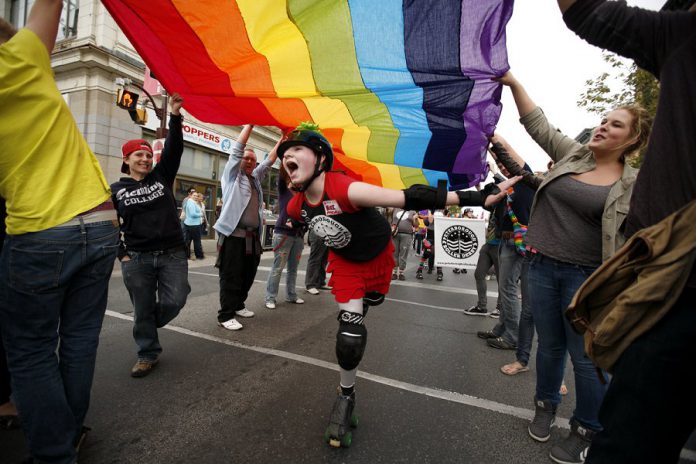
The rainbow flag, commonly called the gay pride flag and sometimes the LGBTQ+ pride flag, is a symbol of lesbian, gay, bisexual, and transgender pride, and LGBTQ+ social movements.
Its colours reflect the diversity of the LGBTQ+ community, and the flag is often used as a symbol of Pride in LGBTQ+ rights marches. It originated in California but is now used worldwide.
Designed by San Francisco artist Gilbert Baker in 1978, the design has undergone several revisions to first remove, then re-add colours, due to widely available fabrics. As of 2008, the most common variant consists of six stripes featuring the colours red, orange, yellow, green, blue, and violet.
The flag is commonly flown horizontally, with the red stripe on top as it would be in a natural rainbow.
The original gay pride flag flew in the San Francisco Gay Freedom Day Parade on June 25, 1978. It has been suggested that Mr. Baker was inspired by Judy Garland’s singing of “Over the Rainbow” and the Stonewall riots that happened a few days after Garland’s death. Thirty volunteers hand-dyed and stitched the first two flags for the parade.

After the November 27, 1978, assassination of openly gay San Francisco city supervisor Harvey Milk, demand for the rainbow flag greatly increased. To meet the demand, the Paramount Flag Company began selling a version of the flag using stock rainbow fabric consisting of seven stripes of red, orange, yellow, green, turquoise, blue and violet. As Baker ramped up production of his version of the flag, he too dropped the hot pink stripe because of the unavailability of hot-pink fabric.
The rainbow flag celebrated its 25th anniversary in 2003. During Pride celebrations in June of that year, Mr. Baker restored the rainbow flag back to its original eight-striped version and has since advocated that others do the same. However, the eight-striped version has seen little adoption by the wider gay community which has mostly stuck with the better known six-striped version.
That said, various variations of the rainbow flag are still widely displayed, including at Peterborough’s annual Pride Parade.
The flag’s colours, and their meaning, are as follows: red, life; orange, healing; yellow, sunlight; green, nature; turquoise, magic/art; blue, serenity/harmony; and violet, spirit.
Today, you’re likely to see a version designed by Daniel Quasar — commonly known as the “Progressive Pride Flag” or “Inclusive Pride Flag” — that adds a triangular chevron to one side, with colours honouring the trans community as well as people of colour. You may also see a version pioneered in Philadelphia that puts black and brown stripes at the top.
Did You Know…? LGBTQ+ Terminology Explained
2SLGBTQA+
Stands for Two Spirit, Lesbian, Gay, Bisexual, Transgender, Queer, Intersex, Androgynous and Asexual. This is by no means a comprehensive list of identities and these definitions tend to shift and expand as the dominant culture changes. As such, the acronym includes identities that are commonly used today.
Two Spirit
Refers to an Indigenous person on Turtle Island (North America) whose gender experience or sexual orientation incorporates both or lies outside of a male/female binary. Two Spirit people were specifically targeted during early colonization for their apparent queerness and were largely erased from history. The term Two Spirit, however, is recent and comes from the 1990 Native American/First Nations Gay and Lesbian Conference in Winnipeg. A Two Spirit person may or may not also identify as LGTBQA+. Two Spirit is a term created by and for Indigenous peoples only, and is not a term for non-Indigenous people to identify as.
Lesbian
Relating to a woman, or femme-aligned non-binary person, who experiences attraction emotionally, romantically, and/or physically for other women or femme-aligned non-binary people.
Gay
Relating to a man, or masculine person, who experiences attraction emotionally, romantically, and/or physically for other men or masculine people.It is also an umbrella term often used to refer to non-heterosexual sexual identities.
Bisexual/Pansexual
Relating to any person who experiences attraction emotionally, romantically, and/or physically for one or more genders. Pansexuality expands upon this to include all genders. There is considerable overlap between bisexuality and pansexuality and so it is left up to the individual to decide how they wish to define themselves.
Transgender or Trans
Relating to a person whose assigned gender is not congruent with how they experience their gender.
Non-Binary
Refers to a person whose gender experience cannot be entirely described by binary identities like “man” or “woman.”
Cisgender
Refers to a person who is content with the gender they were assigned at birth.
Queer/Questioning
Historically, “queer” was used as a derogatory term to refer to homosexual people and as such should only be used as a form of reclamation. i.e. It is rude to call someone queer who does not openly identify this way or has not given you permission to do so. Queer is a personal identity, meaning it tends to have individual definitions for individual people. It is also often now used as an umbrella term in much the same way that “gay” is.
Questioning refers to people who are not certain of their identity and who require a safe space to explore their possibilities.
Asexual/Aromantic
Two distinct terms that refer to a person who experiences either little, conditional, or no sexual or romantic attraction.


